As a coach and runner, I look forward to the weeks around New Year’s because my clients and I plan our training seasons in preparation for spring and summer goal races. I also start working with some new clients and get them on a consistent weekly routine.
Having spent the past two weeks creating several long-range training plans that span 16 to 24 weeks in preparation for a top-goal ultra, as well as developing base-building weekly plans, I thought I’d share the process and use my own training horizon as an example. For the 19 weeks between Jan. 1 and May 14, I’ll be training for the Mauna to Mauna Ultra, an inaugural seven-day, self-supported, 250K (156 mile) race on the Big Island of Hawaii.
Many of us spent the past month, between Thanksgiving and New Year’s, running minimally and taking a break from structured training. Some of us stopped running in favor of snow sports. Cold and wet weather discouraged consistent, quality runs. It was a busy time of year due to the holidays, family and travel. For these reasons and more, weekly mileage tended to go down for many runners over the past six weeks, while food and alcohol consumption probably went up.
Personally, I didn’t do much long or quality running after the November 26 Quad Dipsea; my weekend long run became medium length, and I took it easier during the week, so total weekly mileage dipped down to the 30 – 35 mile range. And, admittedly, my food and alcohol consumption spiked. I’m therefore starting 2017 with work to do to get back in shape.
I generally break a training season that leads up to an “A”-level ultra-distance goal race into four phases:
1. Base (Re)Building
This is the time to establish or re-establish consistent weekly training. Consistency is key! Everyone is different, so please don’t think this is a one-size-fits-all recommendation; but, generally speaking, a good, solid training week for long-distance running features:
- At least four, preferably five or six, runs.
- Three of those runs should be more challenging runs; typically: (1) a midweek run with speed intervals to develop cardiovascular fitness and running economy; (2) a midweek run longer in duration than other midweek runs and including hill work for strength and fitness; and (3) a weekend long run at a relaxed but efficient and sustainable pace to develop endurance, cultivate patience, and practice troubleshooting, refueling and rehydrating over long distances.
- The other runs during the week should be shorter, relaxed easy runs at a conversational pace. Schedule these between your harder days. These easy-run days help you adapt to the stress of the hard days and make progress. One of my favorite sayings is, “Make your easy days easy, and your hard days hard.”
- Layer in upper-body conditioning (emphasizing core/glute), and lower-body PT (emphasizing balance, flexibility, and exercises to address weak or trouble spots) for 20 – 30 minutes, two to three times a week.
- Cross-train once/week (e.g. spin, skiing) if you enjoy it, but it’s not necessary; I prefer low-impact cross-training activities, like swimming or yoga, for active recovery after a hard run, as opposed to engaging in an intense, challenging cross-training activity.
- Have a complete rest day and let yourself sleep in at least one day a week.
- Focus on health & nutrition. If you’re heavy, then use healthy eating strategies (see related blog post) to get closer to race weight early in your training cycle, as it will help you feel and perform better for the remainder of your training.
- Generally speaking, the base-building phase is not a time to race. You may do a “fun run” race as a supported long run, but don’t really push yourself, because you’re not yet ready to race. You’ll stress your body and require extra recovery days, which interferes with the pattern of weekly training you’re trying to establish.
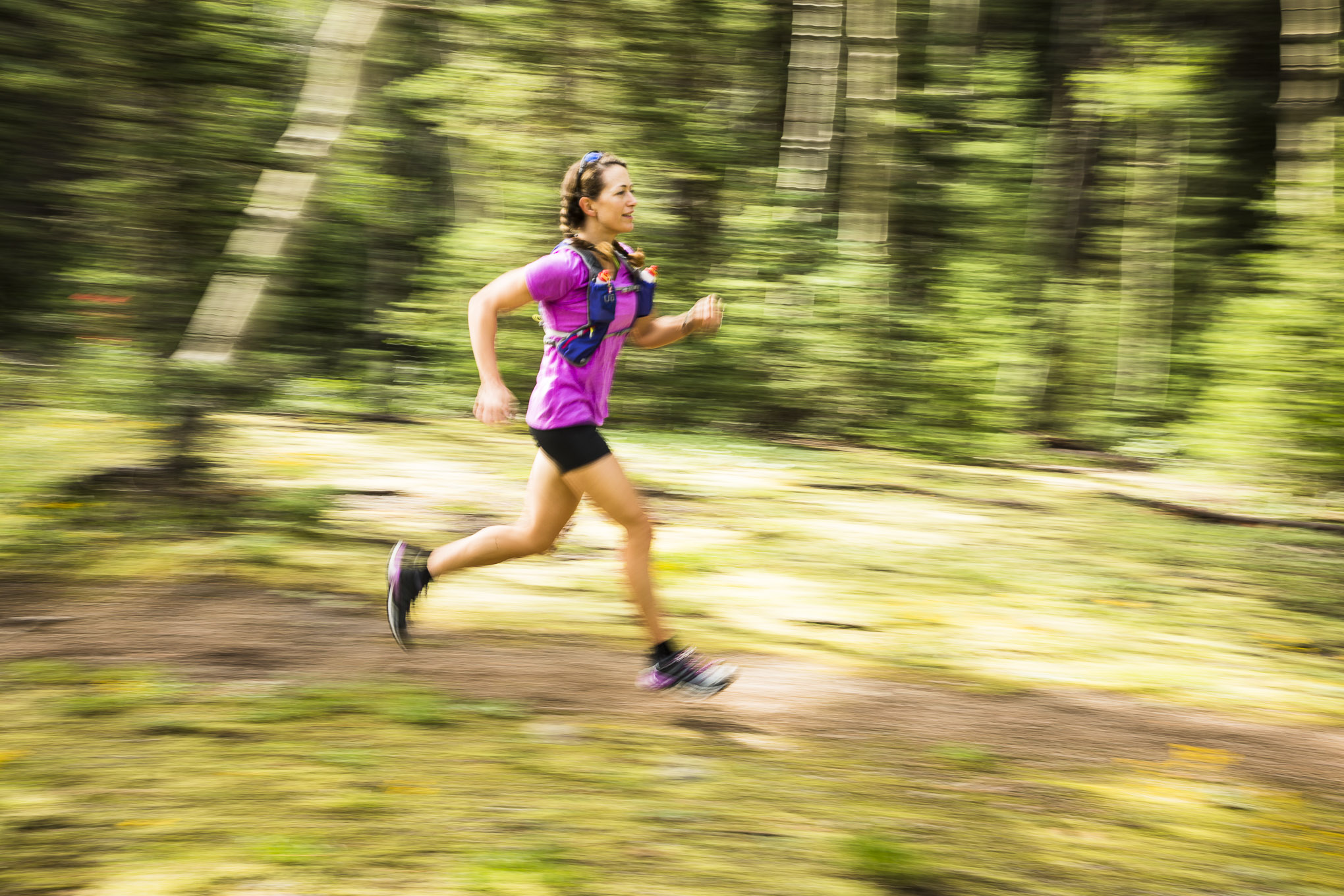
You don’t need to go to the track for speedwork; do timed intervals on the trail. (photo by James Kao)
During base-building, frequency and consistency matter more than duration. Your “long” runs don’t need to be significantly long. Base-building can last anywhere from four to eight weeks, depending on your prior level of fitness and experience. You’ll know you have your base back when the weekly training feels routine and less challenging.
For me, I’ll rebuild my base during the month of January; I’ll get back to a routine of a harder run on Tuesdays, during which I push the uphills, do stair repeats, and go a little longer; a weekly speed session with intervals on Thursdays; a longer run on Saturdays; and, I’ll once again get habitual about strength conditioning and PT. I’ll run shorter and easier on Monday, Wednesday (or alternatively, Friday) and Sunday, and also rekindle the habit of doing some yoga at bedtime. I have a 50K race scheduled January 21, but I’m doing this as a challenging, steady long run, not a real race, so I will train through it rather than taper for it.
2. Enhance Your Fitness and Increase Your Volume
During this phase, you should continue to follow the weekly pattern described above, but turn up the intensity of your hard-day workouts, and incrementally increase the duration of your long run.
I continue to favor short-interval speed workouts during this phase, because they are so effective for building fitness. On the other weekday hard run that involves hill work, I recommend growing the distance to be at least half the duration of the weekend long run; e.g. if you have 18 miles or approximately 3 hours scheduled for the weekend, aim for this harder hilly midweek run to be around 9 miles or 1.5 hours. I also like introducing plyometrics at the end of one of these weekday hard runs, for added lower-body strength-building and cardio, such as a couple of sets each of: high-knee skipping, grapevines, box jumps and one-legged squats (plus a couple of other lower-body exercises emphasizing ankle/Achilles/foot care and balance).
Build up your volume and intensity week by week gradually and carefully, and every three to four weeks, give yourself an easier week. Let yourself rest more; shorten your long run; make one of your midweek hard runs less intense. An easier week like this once a month will help prevent burnout. If you look at your calendar and see a difficult week due to work or travel, then plan ahead to make that your easier running week.
This phase is a good time to do a shorter practice race that serves as a stepping stone and dress rehearsal for the big goal race. Push yourself to race it well—which means, give yourself a one-week taper leading up to it, and a few extra days of recovery after it. If you’re training for a 50K, for example, then race a trail half marathon or 30K. Practice tapering and race-day prep (described in the Taper phase below), and during the race, practice smart pacing, efficiency at aid stations, and refueling/rehydrating.

In March of 2016, I used the Marin Ultra Challenge 50K as a practice race leading up to Lake Sonoma 50M, which also was a stepping stone to the season’s “A” goal of Western States 100. I raced this event hard and made my goal of finishing close to 5 hours (5:03).
Depending on the time horizon to your goal race, this phase can last anywhere from four to eight or more weeks. Personally, this phase will encompass February and the first week of March. I’m registered for a 50K on February 25 that I’ll race hard and competitively, to test my fitness and practice race-day execution.
One final note: By now, you should have all your logistical arrangements in place for your main goal race. Don’t wait til the last minute to book lodging or figure out transportation to the start line. Take care of those details early, so you avoid stress approaching race day.
3. Train Extremely Specifically for Your Goal Race and Peak in Volume
At this point, all your training should focus on specific preparation—physical, mental, logistical—for the goal race.
Early in this phase, “do your homework” and learn as much as you can about your goal race, through others’ race reports and the event website, and visualize the race as you run. Practice your mental game as well (see related post). Develop and fine-tune a race-day plan for details such as drop bags, crew, pacing, calories and hydration, etc.
This is the time to deliberately practice the terrain and hill profiles of your goal race; to adapt to the climate as best as possible (e.g. start heat training in prep for a hot race); and to run at different times of the day to mimic running during the time of day when your ultra will be. If you are doing a 50-mile or longer ultra when you will need to take in substantial calories, then focus on adapting your gut by fine-tuning your refueling strategies and occasionally running while digesting (e.g. after a light lunch or dinner). Practice nighttime running a few times if your ultra will take you past sunset.
During this phase, when specificity and volume peak, your once-a-week speedwork should transition away from shorter intervals, to a “comfortably hard” tempo pace that you can sustain for at least 25 to 30 minutes. During a midweek run lasting an hour or more, for example, you could run 30 minutes at this higher-intensity but sustainable tempo pace; or, you can try a negative split run, where you run the second half progressively faster.
If you are training for a 50-mile or longer ultra, I also recommend carefully scheduling a few back-to-back long runs, about once every three or four weeks. This allows you to adapt to running/hiking on fatigued legs and more closely simulate what an effort that lasts some 10 to 30 or more hours (for a 50- to 100-mile race) would feel like. I like to break a back-to-back unevenly, with longer mileage on the first day; for example, 30 miles on a Saturday, 15 to 20 very slow miles with a lot of hiking mixed in on the Sunday. If possible, participate in a 50K in this phase as a supported long run, and then have a significant long run the following day for a back-to-back effort.
I also recommend a weekly “two-a-day” during this phase, especially for morning runners who are unaccustomed to running late in the day. Add an easy-pace run for an hour or so in the late afternoon or early evening on a day when you also run in the morning; but, expect this “easy” run to feel hard—that’s the point; you’re adapting to late-day running on fatigued legs to practice for your ultra!
Don’t forget to have a “cutback week” every three to four weeks when you allow for lower mileage and more recovery; these are good to schedule following a weekend back-to-back run. Also, phase out cross-training activities; it’s better to train specifically for your race, by running and hiking, or rest completely, rather than adding another activity such as cycling. (Note: I use “cross training” to refer to other recreational activities like cycling, rowing or swimming; “conditioning” to refer to specific exercises for strength, injury prevention and flexibility. Keep doing conditioning two to three times a week, for 20 or so minutes at a time.)
It’s important to time this peak phase properly, so you don’t peak in your training too early. A four-to-six-week time frame is good for a 50K or shorter race; for a longer ultra, build in more time for this phase. Last year, when my goal race was the 100-mile Western States Endurance Run, I gave myself the eight weeks from the third week of April (following a week of recovery from the Lake Sonoma 50), to the first week of June (allowing for a two-week taper), for this peak phase.
I recommend scheduling the longest, most depleting long runs five and six weeks before the goal race; then, on the weekend four weeks before the race, schedule a long run, but not quite as long and depleting. Three weekends before the race, have a long run approximately 75 percent of the peak-long-run distance, and then start tapering.
As I train for the Mauna to Mauna Ultra, I’ll shift to this phase in March and spend all of March and April training very specifically and peaking in volume. For a multi-day, self-supported stage race, a great deal of specialized training and gear prep is required, such as getting used to running with a pack that weighs approximately 20 pounds, adapting to the hot and humid climate we’ll face, running multiple back-to-back long runs, and subsisting on a limited calorie supply (because we have to carry all our food for the week).
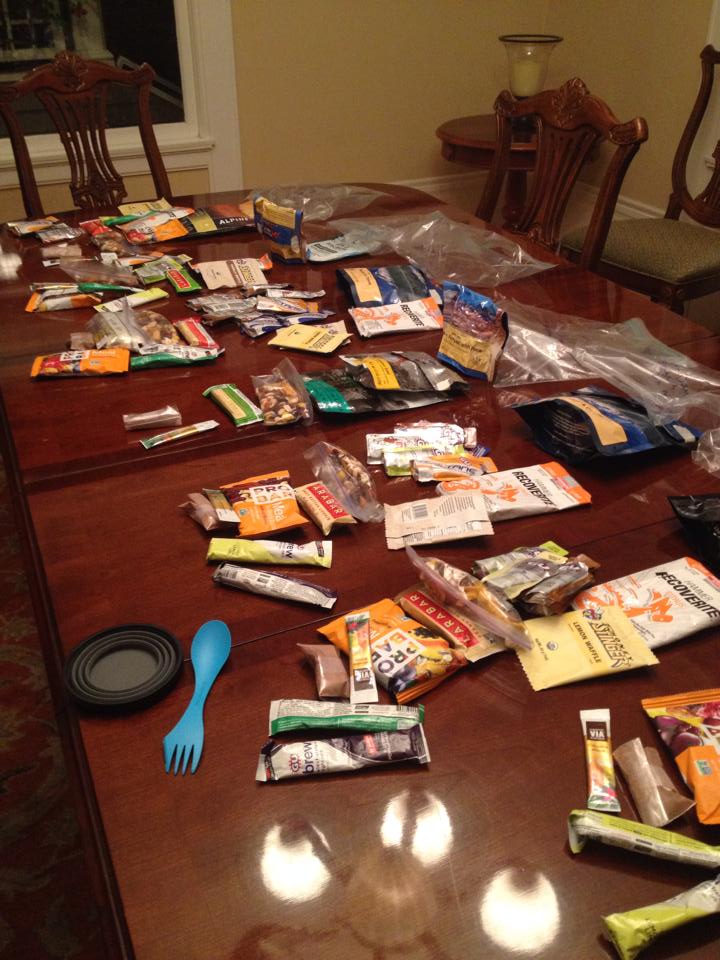
Getting ready for a multi-day, self-supported stage race, I’ll have to spend a lot of time planning all of THIS! (This shows the calories I assembled for each day of the 2014 Grand to Grand Ultra.)
For pack training, I’ll start by walking as much as possible during the day with my adjustable weighted vest (using 10 to 20 lbs), and as much as my schedule allows, I’ll literally run errands—that is, go shopping with an empty backpack, running to the shopping district a couple of miles away, and walk home with a loaded backpack. This kind of time-on-feet training in addition to regular running is excellent preparation for a multi-day stage race. I’ll also start hitting the sauna to adapt to Hawaii’s humid climate, and use time in the sauna to do some strength conditioning (especially core/glute work) and PT exercises.
For peak training runs, I’ll pace/crew my friend for 30 to 40 miles in the dark at the Zion 100 in early April, while wearing a pack; then, the following weekend, I’ll do the Mount Diablo 50K also wearing a loaded pack for a super-slow, challenging long run.
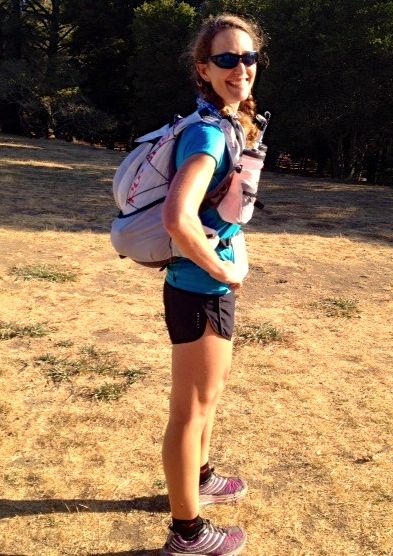
This shows me in August 2014, when I was pack training for the Grand to Grand Ultra and ran a 50K with a full pack. It takes me at least an hour extra to finish with the pack, but it’s good training! This time, however, I plan to use Ultimate Direction’s 30L Fastpack instead of this pack by Raidlight.
Mentally, I’ll cultivate patience and the slow-and-steady pace that running/hiking with a backpack requires. In terms of volume, I want to reach the point where I normalize a 20-miler; that is, I’m able to run a 20-miler midweek without much problem and without feeling like it’s a big deal, and truly long runs will be in the high 20s to mid 30s range, with several back-to-backs.
4. Taper
The taper is hard to get right. The idea is to reduce your volume, and emphasize rest, in the two to three weeks before the ultra, to arrive at the starting line as fit, healthy, rested and stress-free as possible. Too many runners arrive at the start line tired and frazzled from too much training and life stress or travel stress; or, they’re heavy and sluggish from too little running with too little intensity, and perhaps too much eating.
Here are six things I recommend during a taper (the devil is in the detail; I’m giving only general recommendations because how and how much you should do the following differs for individuals and depends on the specific event):
- reduce the duration of your long run: The weekend before a goal race, my “long” run generally tops out at two hours.
- reduce the volume of your weekday runs, but maintain some high intensity: I still run some fast miles during the taper. The Tuesday before a weekend race, I like to do a last, short speedwork session, which generally involves a set of strides and a couple of mile repeats.
- eat and hydrate well: This can be tough, especially if you’re traveling to a destination race and eating out in the days leading up to race day. Listen to your hunger and fullness cues, and avoid overeating. Also cut back or entirely cut out alcohol. Don’t “diet” or restrict calories during the taper in an effort to be lighter and faster on race day, as this will backfire by stressing you out and depleting your energy; instead, address your weight management, and maintain a healthy race weight, earlier in your training season.
- store up on sleep: Let yourself wake naturally on as many mornings as possible. Get a good night’s sleep two nights before the race, to compensate for possible insomnia and early waking on race day.
- avoid illness and injury: Be germ-phobic; avoid sick people, and wash your hands frequently. Don’t do any new or unusual activities out of restlessness, such as cleaning out a closet or gardening, as this could cause muscle strains or soreness.
- when in doubt, think “less is more”: Your physical training is in the bank. Doing too much during the taper is riskier than doing too little. Focus instead on sleep, nutrition and overall wellness.
Mental and logistical preparation—which you should have started in the prior phases—should be fine-tuned and rechecked. Go over your race plan; check the event website for last-minute announcements. If you are using a crew, go over your plans with them. (Check out my article from the December issue of Trail Runner, “Avoid the Crew Snafu.”) Make sure you have a foolproof plan for getting to the starting line with plenty of time to spare.
I’m admittedly nervous about my taper period for the Mauna to Mauna Ultra, because it will involve stress and then temptation. For the first weekend of May, when I’ll start tapering, I’ll have to travel to and handle presenting at a board meeting in my role as a school trustee. There’s always a lot of work involved with getting ready for those meetings. Then as soon as the meeting ends, I’ll fly to Hawaii with my husband for five days of vacationing together before the Mauna to Mauna event begins. That means five days in paradise with my husband, relaxing and acclimatizing to the climate, which sounds perfect—except for the temptation of food and drink! I’ll have to be extra careful to moderate intake of this:
And do this, but also in moderation:
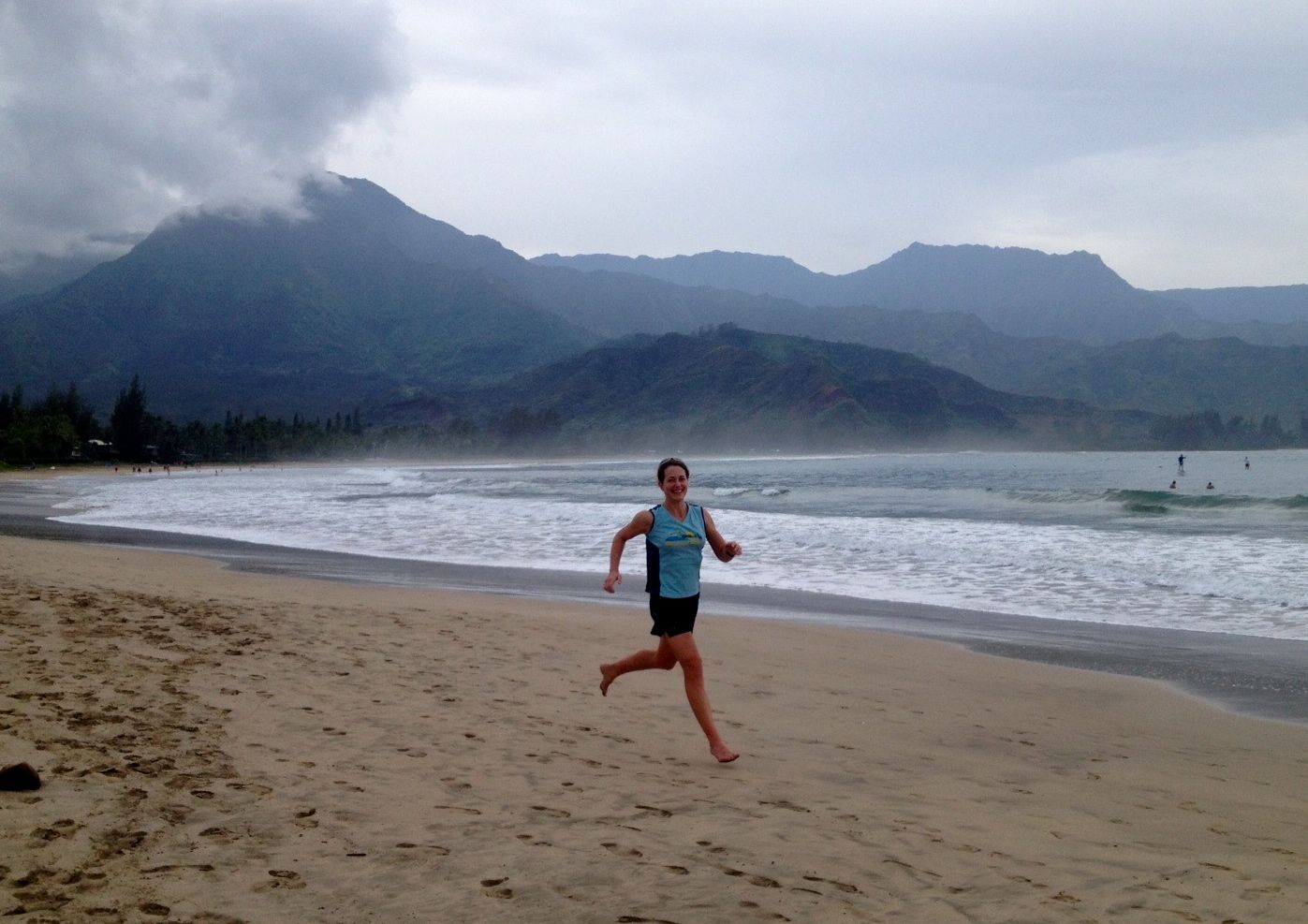
I can’t wait to get back to Hawaii in May for the Mauna to Mauna Ultra! I haven’t been there since Christmas 2012, when this photo was taken.
I hope this post helps and inspires you to do some long-range planning for your training season. Here’s how my six-month season leading up to the 2016 Western States Endurance Run looked last January through June; it included the Sean O’Brien 50K, Marin Ultra Challenge 50K and Lake Sonoma 50M. I’m proud of the injury-free consistency I achieved, and I hope to have a successful buildup again this January through May.


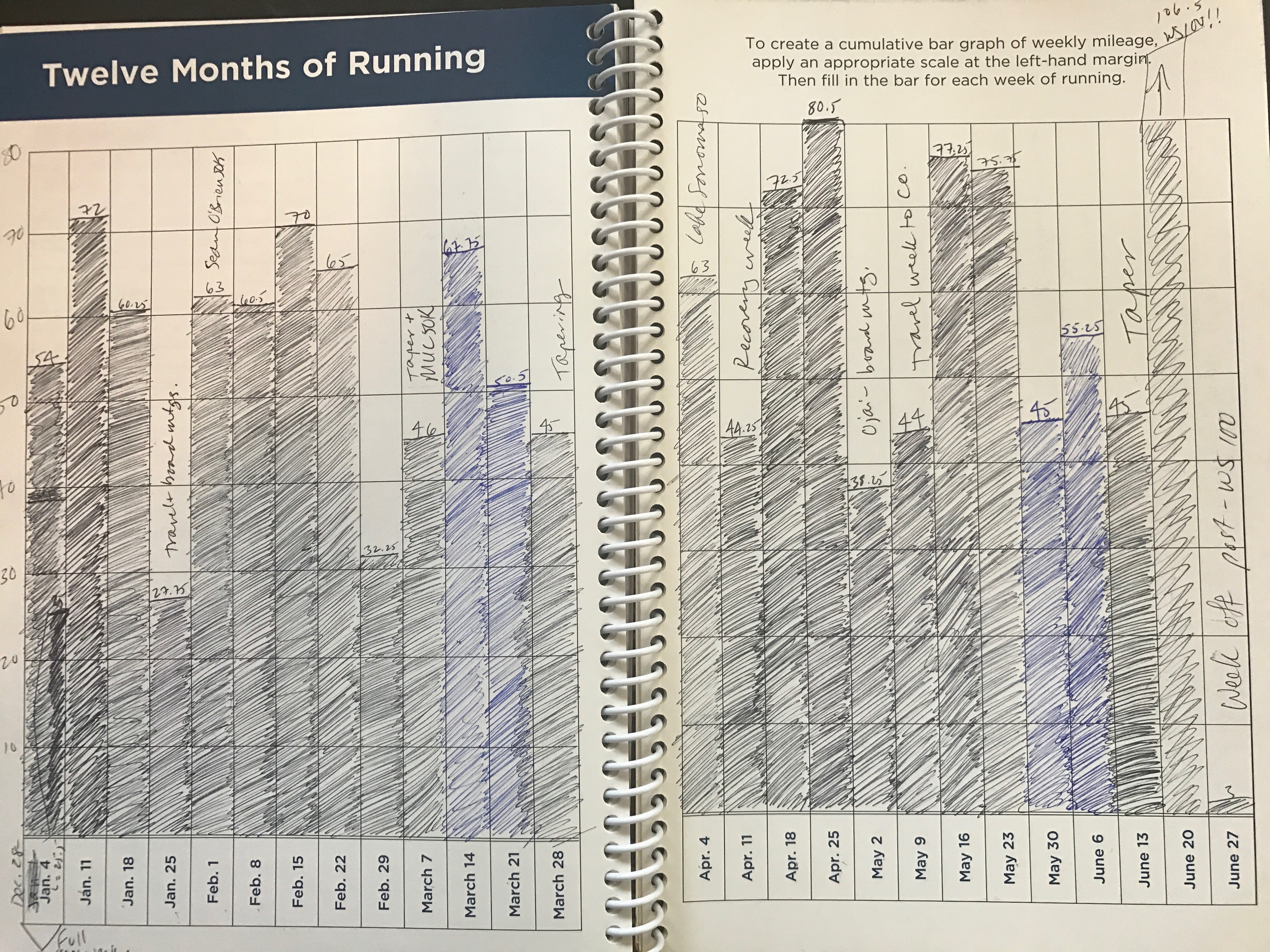
Great post! Looking forward to Hawaii.
Great rundown and explanation of an ultrarunning training season. Hope you have a great racing year!
Trying again.
Me: 50 yr old female marathoner and ultra runner (assuming one 50 two years ago counts). My training is similar to yours in T/Th/Sat – hard, interval, long – with easier runs W/Sun and sometimes M or F. One day off running a week, super light bike as XT. Bought a weight vest. Need to get back into more AIF and strength work (body weight only), and going back to a mostly-Paleo diet (which worked great for me in 13-14) assuming doc okays it next week. Been eating way too much grain/sugar and even if it turns out I’m not gluten-sensitive, think I am processed-carb sensitive. (also, perimenopause, yeesh) Love my treats, but if big diet changes make me feel and run better again….
Goal spring race: Boston Marathon 4/17 – want to do the best I can, finish strong and healthy and have a good experience. Not sure yet re time goals as am working on some medical issues (not injury knocking wood) and the last couple years of life have made my running harder than it was. I’m not where I was in 2014. May set a time goal after a 10mile race in early March, may not. A course PR and re-BQing would be awesome (don’t see a way to a marathon PR) but we shall see if those are possible.
THEN 4 weeks after Boston – as part of my buildup to Comrades 2018 – I am going for 50M at a 24h 1/4mi track race. Goals: finish healthy and feeling reasonably decent considering 😉 and get 50M before I turn 51. (I plan to run a goal fall marathon then go for 100k at Across the Years.)
What adjustments to training – in the 14.5 weeks I have to Boston – would you suggest to allow me to do my best at Boston and inch me toward the 50M. I realize that post-Boston there’s maybe a week – maybe, depending on recovery – where I could “train” before tapering. So I have to go into Boston about as ready as I can be for that as a race and also use it as a final big training stimulus. (and any tips for the post-Boston weeks appreciated too)
If this is too much of a Q, don’t worry about answering, but thought you might have some insight. Enjoy your podcasting writing, looking forward to the book! (when?)
Best,
M
Hi there – sounds like you have an exciting spring ahead! Re Boston: I would figure out a finish-time goal and use that to calculate and practice Marathon Goal Pace on your long runs. Your finish time goal should be based on past performances and the particulars of the course; you should be able to comfortably run a half marathon at that pace. About halfway through your long training run, progress to Marathon Goal Pace and sustain it for several miles; really dial in what that pace feels like. For example, my client was training to run a sub-3:40 marathon, so his MGP for a 3:39 finish was 8:22/mile. He therefore spent many long-run miles at 8:20-8:25/mile range. He also did weekday tempo runs at just under 8 min/mile. In other words, you want to be really in tune with how that goal pace feels, and feel that it’s manageable.
Regarding the weighted vest — I recommended that in the blog post for my pack training. I would not recommend it for marathon training. It’s good for ultra/mountain training, for brisk hiking especially, but it adds extra stress & impact to your lower body, so be careful using it, and I wouldn’t start using it in advance of Boston.
For the 24hr — 24 hours is plenty of time to finish 50 miles, if your body and brain don’t give out! 50 miles typically is a goal for a 12-hour event. Having so much time — and therefore, incentive to stop and rest a lot — may actually backfire; I would aim to try to do 50 steady miles, and if you finish long before the 24 hours are up, that’s great! You can stop at 50M, or decide if you can and want to go past 50M. Check out my blog post from June 2015 on running a 24 hour timed event for specific advice. https://www.therunnerstrip.com/2015/06/my-first-24-hour-timed-ultra/
Post Boston recovery: give yourself several days of rest and active recovery (i.e. walking, yoga, maybe swimming easy laps); work through fatigue and soreness. Then shift your training to physical and mental prep for the timed loop event. Think about how you will transition between run & walk breaks (e.g. I recommend pattens of run walk in a timed event, such as 8 min run, 2 min walk) and practice that. Try to run at different times of the day, especially in the evening, to prepare for the challenge of running late at night.
Good luck! I’m curious to know how it goes.
Thanks!!
This is a great article. Will incorporate some of your ideas on my multistage event. Thanks!
Hey Sarah! Thank you so much for writing this article. I am signed up for G2G 2017, it’s very helpful! I’m trying to choose a pack right now and noticed your photo caption says you are switching from the Raidlight pack (which one?) to the UD Fast Pack. Is there a reason?
Thanks and have a great time at M2M!!
Kim
Hi Kim, I used the RaidLight Ultra Olmo 20 in 2014 and liked it well enough. However, I’m switching to UD’s Fastpack 30 for a couple of reasons. One, I’m sponsored by them :-). But practically speaking, I like the their pack’s rolltop design, like a dry bag, so you can expand it to get max space and progressively roll it down and cinch it tight for a snug fit, which is important because throughout the week, as we eat through our food supplies, the pack’s remaining contents can jiggle around and bounce without a snug fit. (One trick to prevent this is let your sleepign bag out of the stuff sack to fill the extra space.) I have used the Fast Pack 20 on day hikes and like how it fits; I’m going for a larger capacity 30L pack for Mauna to Mauna because I believe I’ll need more clothing options than in the Grand to Grand, given that we’ll be constantly wet from humidity and tropical rain, and then we’ll be freezing cold when ascending the island’s two big mountains. I suggest you visit Ultimate Direction’s site and watch the video on their pack: https://ultimatedirection.com/fastpack-30/
Thank you Sarah! Can I ask why you decided not to go with the WAA pack recommended on the G2G website the two times you raced it? (before UD sponsorship I think). I’m curious as I’ve read a lot about getting packs to work for women, including the review about the RaidLight pack you wrote on the G2G Facebook group. Seems like the WAA pack is very adjustable.
I saw the WAA on others and it didn’t as roomy, and the fabric seemed thicker and heavier. The Raidlight and UD ones are more expandable, especially with the outer stretchy mesh pockets.